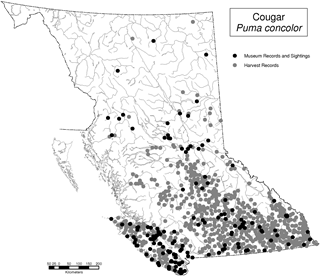Cougars are the largest member of the cat family and live only in the New World. They are slender and agile cats that range from Yukon Territory south all the way to southern Chile and Argentina. They are the second largest wild felid in the Americas, and their size appears to increase with latitude. Males being larger than females; adult males stand about 56 to 79 cm (1.8 to 2.6 ft) tall at the shoulders and females 53 to 76 cm (1.7 to 2.5 ft). Total length from nose to tail is between 2 to 2.4 m (6.6 to 7.9 ft) for adult males and from 1.8 to 2 m (6 to 6.6 ft) in adult females. Males range in weight from around 53 to 72 kg (117 to 159 pounds), with the largest recorded weighing over 125 kg (276 lb). Female weight ranges between 34 and 48 kg (75 and 106 lb). The average weight of 13 adult male cougar from 2 study areas on Vancouver Island, was 55.5 kg and for 26 adult females it was 39.5 kg (Logan and Sweanor 2000).Cougar are generally plain colored which is reflected in the Latin concolor. However, coat colour does vary among individuals even within littermates. Most animals, however are tawny coloured, but some are silvery-grey or reddish brown. All adult individuals have lighter patches on the under side of body including under the the jaws, chin, and throat (Wikipedia 2009). The tip of the tail is black and there are black patches on the back of the ears, and on the sides of the muzzle leading down from the nose. Infants have a reddish- or greyish-brown coat with black spots over the body and black rings on the tail. The spots and tail rings gradually fade as the young grow older and have disappeared usually by about 2 years old. The blue eyes of young when they are born eventually turn to the same amber or brown of adult eyes at around 5 months of age. However, the eyes are closed until about 2 weeks of age. Average birth weight is around 0.5 kg (1 lb) (Logan and Sweanor 2000).
There are no documented occurrences of all-black (melanism) cougar despite some reports. Large black cats, often called "black panthers" is a term used to describe relatively rare melanistic individuals observed in other large cat species, such as jaguars and leopards (Wikipedia 2009). Other common names for cougar include “puma”, “mountain lion”, and “panther”.
The dental formula (for one side of upper and lower jaws each) is incisors 3/3; canines 1/1; premolars 3/2; molars 1/1 - for a total of 30 teeth. The shape of these teeth reflect the cougar’s carnivorous diet. The large sharply pointed canines are used to grip and suffocate their prey, while the upper and lower large flattened premolars (carnassials) work together acting like shears to shear meat and break bones (Logan and Sweanor 2000).
Cougars have large paws with 5 toes on the forefeet and 4 on the smaller hind feet, both with retractile claws. These are used for catching prey for defense or attack, and for climbing trees. Their hind legs are proportionally the largest in the cat family. These morphological characteristics help the cougar run fast and considerable jumps to catch their prey. Cougar can run as fast as 55-72 km/h (35-45 mph), but are adapted primarily for fast sprints of short duration not for endurance (Wikipedia 2009). They are well able to climb trees and often do this to avoid larger carnivores, or when chased by hunters with dogs. They are also known to swim, and in BC are known to swim between islands along the coast.
Cougar; Mountain Lion; Puma
Family: Felidae
Species Information
Biology
|
Habitat
|
Distribution
|
Taxonomy
|
Comments
|
Status Information
|
BC Ministry of Environment: BC Species and Ecosystems Explorer--the authoritative source for conservation information in British Columbia. |
Taxonomic and Nomenclatural Links
Additional Range and Status Information Links
Additional Photo Sources
Species References
|
Arizona Fish and Game Department. Confirmed mountain lion attacks in the United States and Canada 1890 – Present. Caso, A., Lopez-Gonzalez, C., Payan, E., Eizirik, E., de Oliveira, T., Leite-Pitman, R., Kelly, M., Valderrama, C. & Lucherini, M. (2008). Puma concolor. In: IUCN 2008. IUCN Red List of Threatened Species. Currier, M.J.P 1983. Felis concolor. Mammalian Species 200::1-7. Deurbrouck, J. and D. Miller. 2001. Cata Attacks: true stories and hard lessons from cougar country. Sasquatch Books, Seattle. Gladders, A.D. 2003. Predation behaviour of Vancouver Island cougar (Puma concolor vancouverensis) and its relation to micro- and macroscale habitat. Unpubl. M.Sc. Thesis, University of British Columbia. Goh, K.M.L 200. Macrohabitat selection by Vancouver Island cougar (Puma concolor vancouverensis). Unpubl. M.Sc. Thesis, University of British Columbia. Hahn, A.M. 2001. Social and spatial organization of Vancouver Island cougar (Puma concolor vancouverensis, Nelson and Goldman, 1943). Unpubl. M.Sc. Thesis, University of British Columbia. Hatler, D.F., Nagorsen, D.W. and A.M. Beal. 2008. Carnivores of British Columbia. University of British Columbia Press. Vancouver, BC, Canada. 416 pp. Logan, K.A. and L.L. Sweanor. 2000. Puma. Chapter 17, pp. 347-388, in: S. Demarais and P.R. Krausman (eds.) Ecology and management of large mammals in North America. Prentice Hall, N.J. Wilson, S.F., Hahn, A., Gladders, A., Goh, K.M.L. and D.M. Shackleton. 2004. Morphology and population characteristics of cougars on Vancouver Island, Canada. Canadian Field Naturalist 118:159-163. |
